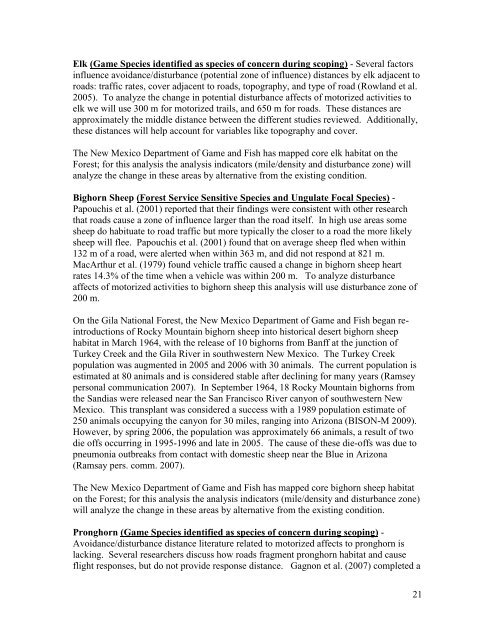Wildlife Specialist report
Wildlife Specialist report
Wildlife Specialist report
Create successful ePaper yourself
Turn your PDF publications into a flip-book with our unique Google optimized e-Paper software.
Elk (Game Species identified as species of concern during scoping) - Several factors<br />
influence avoidance/disturbance (potential zone of influence) distances by elk adjacent to<br />
roads: traffic rates, cover adjacent to roads, topography, and type of road (Rowland et al.<br />
2005). To analyze the change in potential disturbance affects of motorized activities to<br />
elk we will use 300 m for motorized trails, and 650 m for roads. These distances are<br />
approximately the middle distance between the different studies reviewed. Additionally,<br />
these distances will help account for variables like topography and cover.<br />
The New Mexico Department of Game and Fish has mapped core elk habitat on the<br />
Forest; for this analysis the analysis indicators (mile/density and disturbance zone) will<br />
analyze the change in these areas by alternative from the existing condition.<br />
Bighorn Sheep (Forest Service Sensitive Species and Ungulate Focal Species) -<br />
Papouchis et al. (2001) <strong>report</strong>ed that their findings were consistent with other research<br />
that roads cause a zone of influence larger than the road itself. In high use areas some<br />
sheep do habituate to road traffic but more typically the closer to a road the more likely<br />
sheep will flee. Papouchis et al. (2001) found that on average sheep fled when within<br />
132 m of a road, were alerted when within 363 m, and did not respond at 821 m.<br />
MacArthur et al. (1979) found vehicle traffic caused a change in bighorn sheep heart<br />
rates 14.3% of the time when a vehicle was within 200 m. To analyze disturbance<br />
affects of motorized activities to bighorn sheep this analysis will use disturbance zone of<br />
200 m.<br />
On the Gila National Forest, the New Mexico Department of Game and Fish began reintroductions<br />
of Rocky Mountain bighorn sheep into historical desert bighorn sheep<br />
habitat in March 1964, with the release of 10 bighorns from Banff at the junction of<br />
Turkey Creek and the Gila River in southwestern New Mexico. The Turkey Creek<br />
population was augmented in 2005 and 2006 with 30 animals. The current population is<br />
estimated at 80 animals and is considered stable after declining for many years (Ramsey<br />
personal communication 2007). In September 1964, 18 Rocky Mountain bighorns from<br />
the Sandias were released near the San Francisco River canyon of southwestern New<br />
Mexico. This transplant was considered a success with a 1989 population estimate of<br />
250 animals occupying the canyon for 30 miles, ranging into Arizona (BISON-M 2009).<br />
However, by spring 2006, the population was approximately 66 animals, a result of two<br />
die offs occurring in 1995-1996 and late in 2005. The cause of these die-offs was due to<br />
pneumonia outbreaks from contact with domestic sheep near the Blue in Arizona<br />
(Ramsay pers. comm. 2007).<br />
The New Mexico Department of Game and Fish has mapped core bighorn sheep habitat<br />
on the Forest; for this analysis the analysis indicators (mile/density and disturbance zone)<br />
will analyze the change in these areas by alternative from the existing condition.<br />
Pronghorn (Game Species identified as species of concern during scoping) -<br />
Avoidance/disturbance distance literature related to motorized affects to pronghorn is<br />
lacking. Several researchers discuss how roads fragment pronghorn habitat and cause<br />
flight responses, but do not provide response distance. Gagnon et al. (2007) completed a<br />
21
















